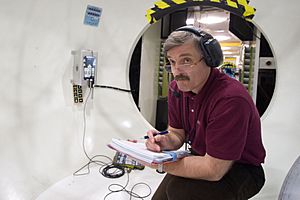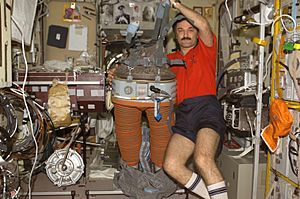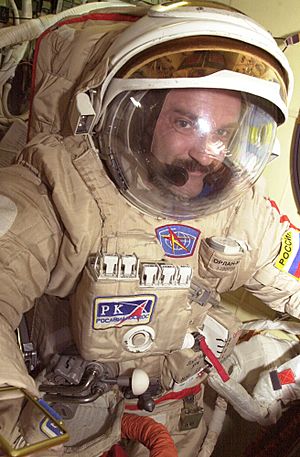Aleksandr Kaleri facts for kids
Quick facts for kids
Aleksandr Kaleri
Александр Калери |
|
|---|---|

Kaleri in 2010
|
|
| Born | 13 May 1956 |
| Status | Retired |
| Nationality | Russian |
| Alma mater | Moscow Institute of Physics and Technology |
| Occupation | Flight engineer |
| Awards | Hero of Russian Federation |
| Space career | |
| Roscosmos cosmonaut | |
|
Time in space
|
769d 6h 37min |
| Selection | 1984 Cosmonaut Group |
|
Total EVAs
|
5 |
|
Total EVA time
|
25 hours 46 minutes |
| Missions | Soyuz TM-14, Soyuz TM-24, Soyuz TM-30, Soyuz TMA-3 (Expedition 8), Soyuz TMA-01M (Expedition 25/26) |
|
Mission insignia
|
       |
Aleksandr "Sasha" Kaleri is a retired Russian cosmonaut. He was born in Jūrmala, Latvia, on May 13, 1956. Kaleri is famous for spending a lot of time on both the Mir Space Station and the International Space Station (ISS).
He has spent the fifth-longest time in space of anyone. His last space mission was in 2010 and 2011. During this time, he worked as a flight engineer on the ISS.
Contents
About Aleksandr Kaleri
Aleksandr Kaleri is married to Svetlana L. Nosova. They have a son named Oleg, who was born in 1996. Kaleri enjoys hobbies like running, reading, and gardening.
Education and Early Career
In 1979, Kaleri graduated from the Moscow Institute of Physics and Technology. He studied how aircraft fly and how to control them. In 1983, he continued his studies at the same institute. He focused on the mechanics of fluids and plasma.
After finishing his education in 1979, Kaleri started working for the Energia Corporation. This company builds spacecraft. He helped design and test parts for the Mir space station. Kaleri is also a skilled computer programmer.
Becoming a Cosmonaut
Aleksandr Kaleri was chosen to become a cosmonaut candidate in April 1984. From 1985 to 1986, he completed his basic training. This training took place at the Gagarin Cosmonaut Training Center. In 1987, he was officially qualified as a test cosmonaut, ready for space flights.
Kaleri trained for several space missions. He was a backup flight engineer for the Mir-3 mission in 1987. He also trained for the Mir-9 mission in 1991. From October 1991 to February 1992, he trained as a main flight engineer for the Mir-11 mission.
Space Missions
Kaleri has flown to space five times. He has spent a total of 769 days, 6 hours, and 37 minutes in space.
Missions to Mir Space Station
Kaleri took part in three long missions aboard the Mir Space Station.
- In 1992, he spent 145 days in space on the Soyuz-TM-14 spacecraft and Mir.
- From August 1996 to March 1997, he spent 197 days on the Soyuz-TM-24 spacecraft and Mir. He was the flight engineer for the Mir-22 mission.
- In 2000, Kaleri completed his third spaceflight. He flew on the Soyuz-TM-30 spacecraft to Mir as the flight engineer for the Mir-28 mission.
Expedition 8 to the ISS
In 2003, Kaleri flew to the International Space Station (ISS) for the first time. This was his fourth spaceflight. He traveled with NASA astronaut Michael Foale. Kaleri was a Flight Engineer for Expedition 8.
He spent 194 days in space, from October 18, 2003, to April 30, 2004. The Soyuz TMA-3 spacecraft, carrying Kaleri, Foale, and ESA astronaut André Kuipers, landed safely in Kazakhstan.
Expedition 25 and 26 to the ISS
Kaleri was a Flight Engineer for ISS Expedition 25 and 26. He launched on October 7, 2010, from Baikonur Cosmodrome. He flew aboard the Soyuz TMA-01M spacecraft with cosmonaut Oleg Skripochka and NASA astronaut Scott Kelly. Kaleri was the commander of the Soyuz spacecraft.
This mission was Kaleri's fifth trip to space. He arrived at the ISS on October 10, 2010. He stayed on the ISS until March 2011. During this mission, Kaleri and his crew did many scientific experiments. They studied physics, human body changes in space, and how crystals grow. They also did educational activities.
Spacewalks
Kaleri has completed five spacewalks, also known as Extravehicular Activities (EVAs). In total, he has spent 23 hours outside a spacecraft.
- First Spacewalk: On July 8, 1992, Kaleri did his first spacewalk. He and cosmonaut Aleksandr Viktorenko checked parts of Mir's gyroscopes. This spacewalk lasted 2 hours and 3 minutes.
- Second Spacewalk: On December 2, 1996, Kaleri and cosmonaut Valery Korzun completed a spacewalk that lasted 5 hours and 57 minutes. They connected a new solar array to give Mir more electrical power.
- Third Spacewalk: On December 9, 1996, Kaleri and Valery Korzun did another spacewalk. It lasted 6 hours and 36 minutes. They finished connecting the solar array and attached a new antenna. They also fixed a radio system.
- Fourth Spacewalk: On May 12, 2000, Kaleri and cosmonaut Sergei Zalyotin spent five hours outside Mir. They inspected the station's exterior. They also tested a special glue to seal small cracks.
- Fifth Spacewalk: On February 26, 2004, Kaleri and NASA astronaut Michael Foale went outside the ISS. They changed experiment packages and put a special dummy on the station's hull. This dummy helped measure radiation in space. The spacewalk was shorter than planned, lasting 3 hours and 55 minutes, because of a problem with Kaleri's spacesuit cooling system.
Awards and Honors
Aleksandr Kaleri has received many awards for his bravery and achievements in space.
- Hero of the Russian Federation (1992) - This is a very high honor for courage during long space flights.
- Order of Merit for the Fatherland (2nd, 3rd, and 4th class) - Awarded for heroism and professionalism during space missions.
- Order of Friendship (2005) - For his dedication and for strengthening friendship between people.
- Medal "For Merit in Space Exploration"
- NASA Space Flight Medal
- NASA Distinguished Public Service Medal
- Chevalier of the Legion of Honour (France, 1997)
- Pilot-Cosmonaut of the Russian Federation (1992) - For his successful space flights.
See also
 In Spanish: Aleksandr Kaleri para niños
In Spanish: Aleksandr Kaleri para niños
- List of Heroes of the Russian Federation




